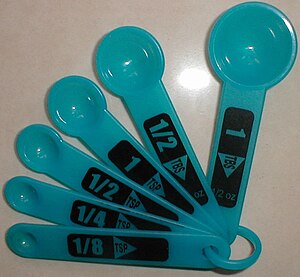Measuring spoon


A measuring spoon is a spoon used to measure an amount of an ingredient, either liquid or dry, when cooking. Measuring spoons may be made of plastic, metal, and other materials. They are available in many sizes, including the teaspoon and tablespoon.
Country differences[]
International[]
Metric measuring spoons are available in sets, usually between four and six, typically with decilitre (100 ml), tablespoon (15 ml), teaspoon (5 ml) and millilitre measures.[citation needed] For fractional measures, there is often a line inside to indicate "half" or "a quarter", or a separate measure may be included, like 1⁄2 dl.
United States[]
In the U.S., measuring spoons often come in sets, usually between four and six. This usually includes ¼, ½, and 1 teaspoon and 1 tablespoon.[1] The volume of a traditional US teaspoon is 4.9 ml and that of a tablespoon is 14.8 ml, slightly less than that of standard metric measuring spoons.
Japan[]
In Japan, usually two spoons are used: a large spoon (大さじ, Ōsaji) and a small spoon (小さじ, Kosaji or Shōsaji). A large spoon is 15 milliliters, and a small spoon is 5 milliliters. Sometimes a much smaller spoon may be used, usually a 2.5 milliliter spoon (½ small spoon).
Measuring with cutlery spoons[]
Cutlery in many countries includes (besides the fork and knife or butterknife) two spoons, which are referred to as a teaspoon and tablespoon — but not to be confused with measuring spoons. As cutlery, these spoons are not standardized and may hold 2.5 to 7.3 ml for teaspoons[2] and 7-20 ml for tablespoons. The difference in size can be dangerous when used for critical measuring, like medication.
See also[]
References[]
- ^ Roupe, Diane (Oct 26, 2009). The Blue Ribbon Country Cookbook. Thomas Nelson Inc. p. 36. ISBN 9781418568214.
- ^ "Spoons give wrong medicine doses". NHS UK. 15 July 2010. Retrieved 21 February 2020.
- Spoons
- Food preparation utensils
- Cooking weights and measures
- Volumetric instruments
- Units of volume
- Kitchenware stubs